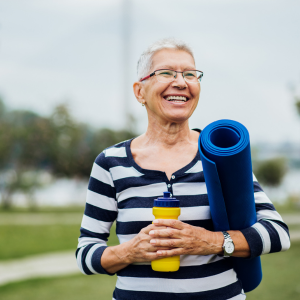For seniors with diabetes, regular exercise is a crucial component of managing the condition.
It offers numerous health benefits, including improved blood sugar control, enhanced cardiovascular health, weight management, increased muscle strength, and better mental health.
This article will explore these benefits and provide a guide to recommended exercises for seniors with diabetes.
Benefits of Exercise for Older Adults with Diabetes

- Improved Blood Sugar Control: Regular physical activity helps in regulating insulin sensitivity and blood sugar levels (Centers for Disease Control and Prevention, 2022).
- Enhanced Cardiovascular Health: Exercise reduces the risk of heart diseases by improving circulation and heart function (Johns Hopkins Medicine, n.d.).
- Weight Management: Active seniors can maintain a healthier weight, which is key in managing diabetes (National Institute on Aging, n.d.).
- Increased Muscle Strength: Stronger muscles improve mobility and balance, reducing the risk of falls (National Institute on Aging, n.d.).
- Boosted Mental Health: Regular exercise can alleviate symptoms of depression and anxiety (Johns Hopkins Medicine, n.d.).
Things to Be Aware of While Exercising

When exercising with diabetes, it’s crucial to be mindful of several key factors to ensure safety and maximize the benefits of physical activity.
First and foremost, individuals should monitor their blood sugar levels before and after exercise, as physical activity can significantly impact glucose levels (Mayo Clinic, 2022).
It’s advised that people with Type 1 or Type 2 diabetes ensure their blood sugar is less than 250 mg/dl before starting to exercise. Exercising with higher blood sugar levels may lead to ketoacidosis, a potentially life-threatening condition (Cleveland Clinic, 2023).
Hydration is another important consideration; adequate water intake before, during, and after exercise is essential to prevent dehydration (Cleveland Clinic, 2023).
Additionally, seniors with diabetes should be prepared for episodes of low blood sugar and carry quick sugar sources like hard candy, glucose tablets, or juice.
Wearing a medical alert ID band is advisable during exercise for quick and appropriate treatment in case of emergencies.
Carrying a cell phone is also recommended for safety reasons, especially when exercising alone (Cleveland Clinic, 2023).
Moreover, choosing the right footwear and socks is crucial to protect the feet, as diabetes can lead to reduced sensation, making it hard to notice injuries (National Institute on Aging, n.d.). This is also why it’s important to look at your feet daily, in the morning and in the evening! If you have diminished sensation and get a blister at the bottom of your foot, it could easily get infected without you even knowing it.
Lastly, it’s important to listen to the body and stop exercising if any symptoms like shortness of breath, dizziness, or lightheadedness occur, and report any unusual problems to a doctor (Cleveland Clinic, 2023).
Recommended Exercises for Seniors with Diabetes

Just like for all seniors (whether one has a chronic condition or not) weekly exercise routines should include activities that challenge the cardiovascular system (like walking, jogging, swimming, biking), as well as aim to increase muscular strength (weight training, resistance band work, etc.). Additionally, balance and flexibility should also be included in all workout plans for older adults (Pilates, Yoga, stretching, Tai Chi).
Exercise Routine for Seniors with Diabetes
Click HERE for a video of Dr. Katie, PT, DPT performing all of the exercises!
1. Chair Squats
Benefits: Enhances leg strength and balance.
Instructions:
- Stand in front of a stable chair, feet shoulder-width apart.
- Slowly bend your knees, lowering your body towards the chair.
- Gently touch the chair with your buttocks, then stand back up.
- Repeat 10 times, ensuring steady breathing.
2. Wall Push-Ups
Benefits: Strengthens upper body and core.
Instructions:
- Stand facing a wall, arms extended, palms on the wall.
- Bend your elbows, bringing your chest closer to the wall.
- Push back to the starting position.
- Perform 10-15 repetitions.
3. Jumping Jacks
Benefits: Improves cardiovascular health.
Instructions:
- Stand upright with your legs together and arms at your sides.
- Bend your knees slightly and jump feet away from midline, so they end up about shoulder-distance apart.
- As you jump, raise your arms out to the sides and above your head. Your body should form an “X” shape at the peak of the jump.
- Jump back to the initial position by bringing your legs back together and lowering your arms to your sides.
- Repeat 15-20 times
4. Toe Stands
Benefits: Strengthens calf muscles and improves balance.
Instructions:
- Stand behind a chair, holding it for support.
- Rise onto your toes, then lower back down.
- Repeat 15 times, maintaining control.
5. Arm Circles
Benefits: Enhances shoulder mobility and strength.
Instructions:
- Stand with feet shoulder-width apart, arms extended to the sides.
- Slowly rotate your arms in small circles, gradually increasing the size.
- Perform 10 circles in each direction.
In Summary
Incorporating these exercises into a daily routine can provide significant benefits for seniors with diabetes.
It’s important to start any new exercise regimen under the guidance of a healthcare provider, especially for individuals with chronic conditions.
References:
- Centers for Disease Control and Prevention. (2022). Get Active! Retrieved from CDC website
- Mayo Clinic. (2022). Diabetes and exercise: When to monitor your blood sugar. Retrieved from Mayo Clinic website
- National Council on Aging. (n.d.). The Importance of Physical Activity for Older Adults with Diabetes. Retrieved from NCOA website
- National Institute on Aging. (n.d.). Exercising With Chronic Conditions. Retrieved from NIA website
- Johns Hopkins Medicine. (n.d.). Exercise and the Aging Person. Retrieved from Johns Hopkins Medicine website
- Type A Training. (n.d.). Diabetes And Exercise For Seniors: A Comprehensive Guide. Retrieved from Type A Training website
- Cleveland Clinic. (2023). 5 Best Exercises for People with Diabetes. Retrieved from https://health.clevelandclinic.org
- Mayo Clinic. (2022). Diabetes and exercise: When to monitor your blood sugar. Retrieved from https://www.mayoclinic.org
- National Institute on Aging. (n.d.). Exercising With Chronic Conditions. Retrieved from https://www.nia.nih.gov




